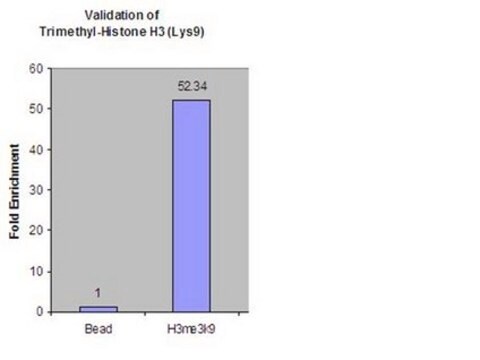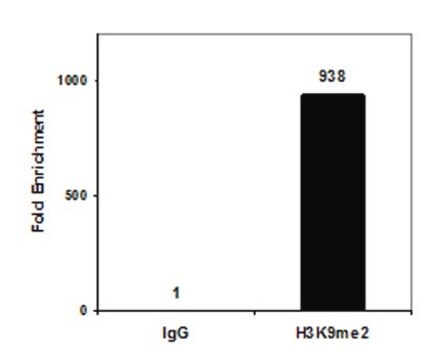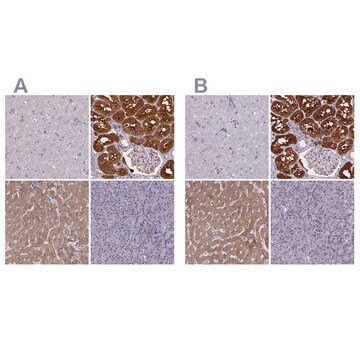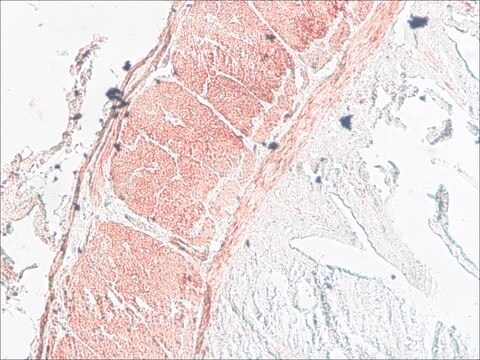05-1242-S
Anti-trimethyl-Histone H3 (Lys9) Antibody, clone 6F12-H4, Trial Size
clone 6F12-H4, from mouse
Synonym(e):
H3K9me3, Histone H3 (trimethyl K9), H3 histone family, member T, Histone 3, H3, Histone cluster 3, H3
About This Item
Empfohlene Produkte
Biologische Quelle
mouse
Qualitätsniveau
Antikörperform
purified antibody
Antikörper-Produkttyp
primary antibodies
Klon
6F12-H4, monoclonal
Speziesreaktivität
mouse, human
Methode(n)
ChIP: suitable (ChIP-seq)
dot blot: suitable
immunofluorescence: suitable
inhibition assay: suitable (peptide)
western blot: suitable
Isotyp
IgG1κ
NCBI-Hinterlegungsnummer
UniProt-Hinterlegungsnummer
Versandbedingung
wet ice
Posttranslationale Modifikation Target
trimethylation (Lys9)
Angaben zum Gen
human ... H3C1(8350)
mouse ... H3C1(360198)
Allgemeine Beschreibung
Spezifität
Immunogen
Anwendung
Epigenetik & nukleäre Funktionen
Histone
Representative data from a previous lot. Sonicated 3T3 L1 chromatin was subjected to chromatin immunoprecipitation using anti- trimethyl-histone H3 (Lys9) and the Magna ChIP G (Cat. #17-611) Kit. Successful immunoprecipitation of trimethylhistone H3 (Lys9) associated DNA fragments was verified by qPCR using primers flanking the p16 promoter.
Peptide Inhibition Analysis:
Peptide blocking assay demonstrates distinct preference of the antibody for the trimethyl form vs. the dimethyl form.
Chromatin Immunoprecipitation (ChIP):
ChIP analysis of known chromosomal Suv39h targets (H3K9me3 in major satellites, mouseES cells).
Dot Blot Analysis:
Dot-blot analysis demonstrating specificity of anti-H3K9me3, clone 6F12-H4 for trimethyl Lys9 of histone H3.
Qualität
Western Blot Analysis: A 0.5 – 5 μg dilution of this lot detected trimethyl histone H3 (Lys9) in HeLa acid extracts.
Zielbeschreibung
Physikalische Form
Lagerung und Haltbarkeit
For maximum recovery of product, centrifuge the vial prior to removing the cap. Avoid freezing, which can damage IgG and affect product performance.
Hinweis zur Analyse
HeLa Acid Extract
Haftungsausschluss
Sie haben nicht das passende Produkt gefunden?
Probieren Sie unser Produkt-Auswahlhilfe. aus.
Lagerklassenschlüssel
12 - Non Combustible Liquids
WGK
WGK 1
Flammpunkt (°F)
Not applicable
Flammpunkt (°C)
Not applicable
Analysenzertifikate (COA)
Suchen Sie nach Analysenzertifikate (COA), indem Sie die Lot-/Chargennummer des Produkts eingeben. Lot- und Chargennummern sind auf dem Produktetikett hinter den Wörtern ‘Lot’ oder ‘Batch’ (Lot oder Charge) zu finden.
Besitzen Sie dieses Produkt bereits?
In der Dokumentenbibliothek finden Sie die Dokumentation zu den Produkten, die Sie kürzlich erworben haben.
Unser Team von Wissenschaftlern verfügt über Erfahrung in allen Forschungsbereichen einschließlich Life Science, Materialwissenschaften, chemischer Synthese, Chromatographie, Analytik und vielen mehr..
Setzen Sie sich mit dem technischen Dienst in Verbindung.








